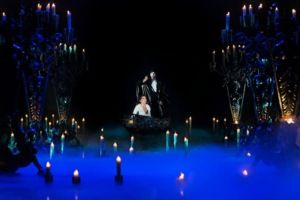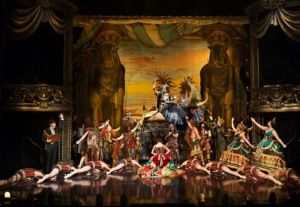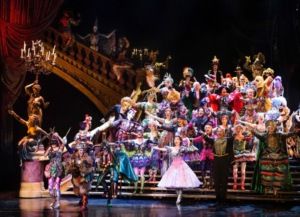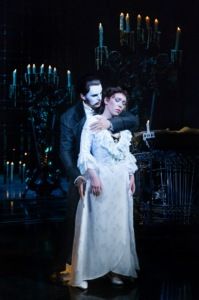Things to do
Performance Review: All hail the eye-popping gothic sweetshop
This article is more than 7 years old.
★★★★★☆

The music of the night is all lit up (all photos: Miklos Szabo)
Globally famous thanks to its endless runs on Broadway and London’s West End, Andrew Lloyd Webber’s musical, based on Gaston Leroux’s 1909 gothic romance novel, first emerged in 1986 and has been performed on a stage, somewhere, ever since.
Ny Teater, old friend
This isn’t the first time Copenhageners have had ‘The Phantom of The Opera’ in their midst either: in 2000 and again in 2009 the Phantom haunted Det Ny Teater to the delight of many thousands of theatre-goers.
Now he’s returned to Det Ny Teater, to once again wreak havoc and claim vengeance on the 19th century Parisian society that shunned and humiliated him. This time he’s portrayed by Tomas Ambt Kofod (and John Martin Bengtsson on alternate evenings), who proved himself in the role previously in Det Ny Teater’s production of Lloyd Webber’s Phantom sequel ‘Lover Never Dies’.
Opposite the Phantom is Christine, the soprano whose talents awaken his amorous and artistic attentions – she’s portrayed by (on this occasion) Sibyl Glosted who was recently awarded the Reumert Talent Of The Year prize. Furthermore, the leads are supported by upwards of a hundred other players in what is a historically huge production.
Images in our collective nostalgia
Initially the most striking element is the late Maria Bjørnson’s design work. The sets are of a big, bold, garish, gothic themepark aesthetic and they ably show a considerable budget exploited to its bloated potential. Now iconic scenes, such as the Phantom’s passage by boat to his subterranean lair below the opera illuminated by multiple candelabra, are faithfully recreated on Det Ny Teater’s stage, provoking the thrill of recognition – even if you’ve never seen the musical, these images exist now in our collective nostalgia. Three decades on they can still provoke genuine wonder.
In terms of scale, the most impressive set-piece is the Masked Ball, which immediately follows the interval. Gillian Lynne’s choreography and staging deserves special mention here. A grand staircase ascends to the rafters, with many of the 100-strong ensemble on stage in an eclectic array of costumes. These cast members are further supplemented by mannequins, to the extent the stage appears to be teeming with life and the effect is breathtaking – particularly when the Phantom appears dressed as Red Death (from Poe’s The Masque of the Red Death) and by ‘magic’ promptly disappears and reappears elsewhere on the stage. It is thanks to such sleight of hand on a grand scale that we become immersed in the illusion and are effectively transported to Leroux’s Paris of old.
Like attending a Lon Chaney premiere
It’s worth adding that Det Ny Teater is the perfect venue for staging this show, not least thanks to its opulent, century-old, 1,000-seater auditorium and the hyggeligt subterranean bar and restaurant (which houses a smaller second stage). Exploring these rooms is recommended, as they are fortuitously in keeping with the tone of the production and even recall the scenography of the silent 1925 Lon Chaney film adaptation.
Given all this eye-popping gothic sweetshop, it’s a credit to the cast that they in no way allow themselves to be upstaged by stage sets and props – Sybil Glosted commands a powerhouse vocal at the heart of her full-blooded Christine and Kofod brings an equally committed muscularity to his titular menace. Elsewhere, Christian Lund as Raoul makes for a convincing count, while levity comes courtesy of Sebastian Harris who displays inspired comic timing as Monsieur André.
Must-see musical theatre
Lloyd Webber isn’t anyone’s first port of call for subtlety – but it is surprising then that, given all this firepower, what is most effectively communicated is the quiet connection between this beast and his beauty: their shared timidity – hers overcome, his protected by a mask, and their pining for the love of a lost parent.
When finally Christine kisses the Phantom, it is genuinely moving – because after having all her actions dictated to her, by either the Phantom or Raoul, this kiss is given entirely of her own volition at the moment his composure and appearance (a still shocking reveal) is most compromised. This is not a kiss given without passion, nor does it express attraction, but rather it is given in her recognition of their connection – to a kindred soul.
His pained howls at her subsequent abandonment of him, are heartbreaking. ‘Phantom’ remains must-see musical theatre.













































